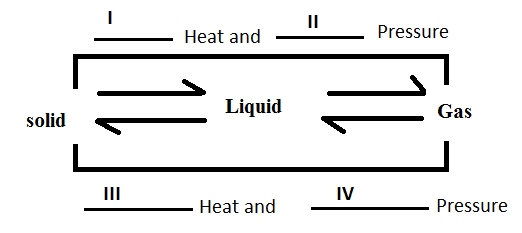
What are I, II, III and IV?

a.) Increase, Increase, Decrease, Decrease
b.) Decrease, Decrease Increase, Increase
c.) Increase, Decrease, Increase, Decrease
d.) Decrease, Increase, Decrease, Increase

Answer
482.1k+ views
Hint: The state of matter in which materials retain their boundaries without support, the atoms or molecules occupying fixed positions with respect to each other and are unable to move freely, they possess high forces of attraction and low kinetic energy.
Gas is a state of matter that has no fixed shape and no fixed volume. Gases have lower density than other states of matter, such as solids and liquids, they possess very low forces of attraction and high kinetic energy.
Complete answer:
The forces of attraction are maximum in the solid state then in liquid and are least in the gaseous state. The energy of the particles decreases as we move from solid to gaseous state as the particles in solid state are packed and have no kinetic energy to move around whereas particles in gaseous phase are free and possess high kinetic energy.
So, the energy or heat in the particles decrease as we move from solid state to gaseous state and pressure also decrease as we move from solid state to gaseous state.
So, the correct answer is “Option B”.
Note: A liquid is a nearly incompressible fluid that conforms to the shape of its container but retains a constant volume independent of pressure. As such, it is one of the four fundamental states of matter, and is the only state with a definite volume but no fixed shape; they possess intermediate forces of attraction and kinetic energy.
Gas is a state of matter that has no fixed shape and no fixed volume. Gases have lower density than other states of matter, such as solids and liquids, they possess very low forces of attraction and high kinetic energy.
Complete answer:
The forces of attraction are maximum in the solid state then in liquid and are least in the gaseous state. The energy of the particles decreases as we move from solid to gaseous state as the particles in solid state are packed and have no kinetic energy to move around whereas particles in gaseous phase are free and possess high kinetic energy.
So, the energy or heat in the particles decrease as we move from solid state to gaseous state and pressure also decrease as we move from solid state to gaseous state.
So, the correct answer is “Option B”.
Note: A liquid is a nearly incompressible fluid that conforms to the shape of its container but retains a constant volume independent of pressure. As such, it is one of the four fundamental states of matter, and is the only state with a definite volume but no fixed shape; they possess intermediate forces of attraction and kinetic energy.
Recently Updated Pages
Glucose when reduced with HI and red Phosphorus gives class 11 chemistry CBSE

The highest possible oxidation states of Uranium and class 11 chemistry CBSE

Find the value of x if the mode of the following data class 11 maths CBSE

Which of the following can be used in the Friedel Crafts class 11 chemistry CBSE

A sphere of mass 40 kg is attracted by a second sphere class 11 physics CBSE

Statement I Reactivity of aluminium decreases when class 11 chemistry CBSE

Trending doubts
10 examples of friction in our daily life

Difference Between Prokaryotic Cells and Eukaryotic Cells

One Metric ton is equal to kg A 10000 B 1000 C 100 class 11 physics CBSE

State and prove Bernoullis theorem class 11 physics CBSE

What organs are located on the left side of your body class 11 biology CBSE

Define least count of vernier callipers How do you class 11 physics CBSE




